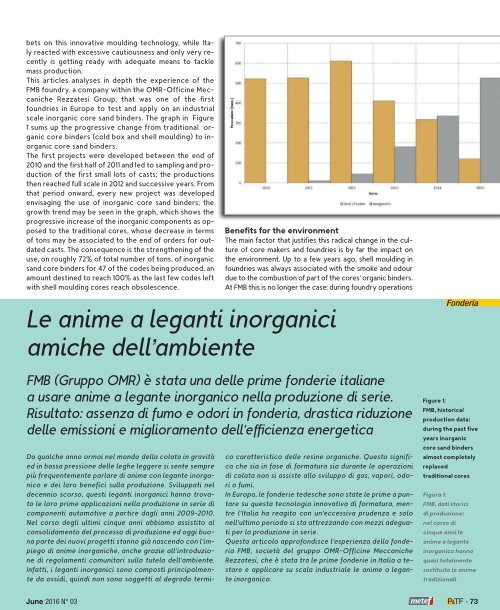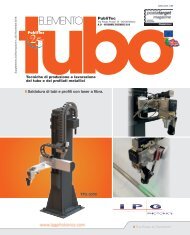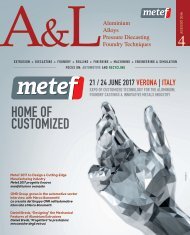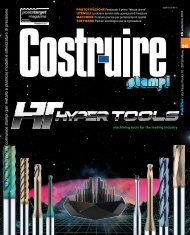Sfogliabile_AeL_n3_GIUGNO_2016
- No tags were found...
You also want an ePaper? Increase the reach of your titles
YUMPU automatically turns print PDFs into web optimized ePapers that Google loves.
ets on this innovative moulding technology, while Italy<br />
reacted with excessive cautiousness and only very recently<br />
is getting ready with adequate means to tackle<br />
mass production.<br />
This articles analyses in depth the experience of the<br />
FMB foundry, a company within the OMR–Officine Meccaniche<br />
Rezzatesi Group, that was one of the first<br />
foundries in Europe to test and apply on an industrial<br />
scale inorganic core sand binders. The graph in Figure<br />
1 sums up the progressive change from traditional organic<br />
core binders (cold box and shell moulding) to inorganic<br />
core sand binders.<br />
Thefirstprojectsweredevelopedbetweentheendof<br />
2010andthefirsthalfof2011andledtosamplingandproduction<br />
of the first small lots of casts; the productions<br />
then reached full scale in 2012 and successive years. From<br />
thatperiodonward,everynewprojectwasdeveloped<br />
envisaging the use of inorganic core sand binders; the<br />
growth trend may be seen in the graph, which shows the<br />
progressive increase of the inorganic components as opposed<br />
to the traditional cores, whose decrease in terms<br />
oftonsmaybeassociatedtotheendofordersforoutdated<br />
casts. The consequence is the strengthening of the<br />
use, on roughly 72% of total number of tons, of inorganic<br />
sandcorebindersfor47ofthecodesbeingproduced,an<br />
amount destined to reach 100% as the last few codes left<br />
with shell moulding cores reach obsolescence.<br />
Benefits for the environment<br />
The main factor that justifies this radical change in the culture<br />
of core makers and foundries is by far the impact on<br />
theenvironment.Uptoafewyearsago,shellmouldingin<br />
foundries was always associated with the smoke and odour<br />
duetothecombustionofpartofthecores’organicbinders.<br />
At FMB this is no longer the case: during foundry operations<br />
Le anime a leganti inorganici<br />
amiche dell’ambiente<br />
FMB (Gruppo OMR) è stata una delle prime fonderie italiane<br />
a usare anime a legante inorganico nella produzione di serie.<br />
Risultato: assenza di fumo e odori in fonderia, drastica riduzione<br />
delle emissioni e miglioramento dell’efficienza energetica<br />
Daqualcheannoormainelmondodellacolataingravità<br />
edinbassapressionedellelegheleggeresisentesempre<br />
più frequentemente parlare di anime con legante inorganico<br />
e dei loro benefici sulla produzione. Sviluppati nel<br />
decennio scorso, questi leganti inorganici hanno trovatoleloroprimeapplicazioninellaproduzioneinseriedi<br />
componenti automotive a partire dagli anni 2009-2010.<br />
Nelcorsodegliultimicinqueanniabbiamoassistitoal<br />
consolidamento del processo di produzione ed oggi buona<br />
parte dei nuovi progetti stanno già nascendo con l’impiegodianimeinorganiche,anchegrazieall’introduzionediregolamenticomunitarisullatuteladell’ambiente.<br />
Infatti, i leganti inorganici sono composti principalmentedaossidi,quindinonsonosoggettialdegradotermi-<br />
cocaratteristicodelleresineorganiche.Questosignifi-<br />
cachesiainfasediformaturasiaduranteleoperazioni<br />
di colata non si assiste allo sviluppo di gas, vapori, odori<br />
o fumi.<br />
InEuropa,lefonderietedeschesonostateleprimeapuntare<br />
su questa tecnologia innovativa di formatura, mentrel’Italiahareagitoconun’eccessivaprudenzaesolo<br />
nell’ultimo periodo si sta attrezzando con mezzi adeguati<br />
per la produzione in serie.<br />
Questo articolo approfondisce l’esperienza della fonderia<br />
FMB, società del gruppo OMR–Officine Meccaniche<br />
Rezzatesi,cheèstatatraleprimefonderieinItaliaatestare<br />
e applicare su scala industriale le anime a legante<br />
inorganico.<br />
Fonderia<br />
Figure 1:<br />
FMB, historical<br />
production data:<br />
during the past five<br />
years inorganic<br />
core sand binders<br />
almost completely<br />
replaced<br />
traditional cores<br />
Figura 1:<br />
FMB, dati storici<br />
di produzione:<br />
nel corso di<br />
cinque anni le<br />
anime a legante<br />
inorganico hanno<br />
quasi totalmente<br />
sostituito le anime<br />
tradizionali<br />
June <strong>2016</strong> N° 03 - 73





